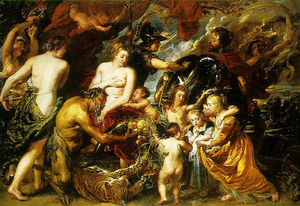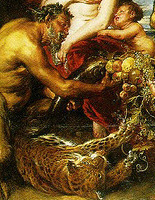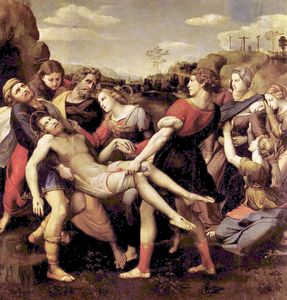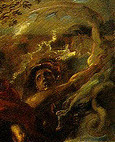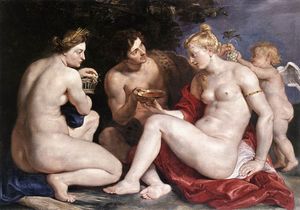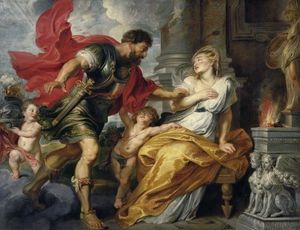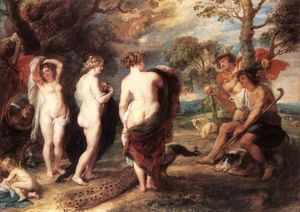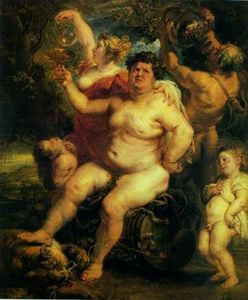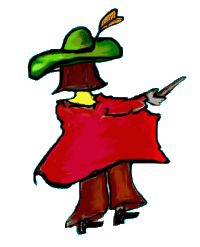Peace and War
- Date of Creation:
- 1630
- Alternative Names:
- Minerva protects Pax from Mars, Allegory of Peace and War
- Height (cm):
- 203.50
- Length (cm):
- 298.00
- Medium:
- Oil
- Support:
- Canvas
- Subject:
- Fantasy
- Framed:
- Yes
- Art Movement:
- Baroque
- Created by:
- Current Location:
- London, United Kingdom
- Displayed at:
- National Gallery London
- Owner:
- National Gallery London
- Peace and War Page's Content
- Story / Theme
- Inspirations for the Work
- Analysis
- Critical Reception
- Related Paintings
- Artist
- Art Period
- Bibliography
Peace and War Story / Theme
In 1629, on behalf of Philip IV of Spain, Rubens was sent to England on another diplomatic mission. While there he decorated the King's Banqueting House and as a gift, he painted Peace and War to encourage the King to prevent war amongst the European nations.
In this work, Rubens draws on ancient Greek and Roman mythological subjects and symbols to convey the beauty that peace can bring to Europe and mankind.
To the far left are two women traditionally dressed as the followers of Bacchus, a fertility god. One holds a basket full of jewels and cups signifying indulgence in good spirits and a reason to celebrate life.
Next to them is a satyr who holds up fruit for the children and Cupid entices them to eat it and enjoy the fruits of peace and goodness that life has to offer. Below lies a leopard who acts like a domestic cat playing with the vine; its wild nature is tamed by the events taking place. It symbolizes the untamed spirit in docility and serenity.
Peace (also known as Pax) is the focus of this work and is represented in the person of Ceres, goddess of the earth. She is shown squirting milk from her breast into the mouth of Plutus, the god of wealth, who is depicted as a child. This gesture shows that peaceful relations nurture prosperity amongst the people and that mankind can prosper socially and economically from peace.
Behind Peace and Wealth is the goddess of wisdom, Minerva. She is presented as a soldier holding up a large shield to ward off Mars, the god of War and Alecto, the fury of war. Minerva protects the humbling scene from potential destruction that looks to break the harmony created. Behind Mars is a woman who represents one of the avenging furies associated with war.
To the bottom right of the image Rubens paints children as symbols of the future of mankind, as they are the ones who will benefit the most from peace. To the left of the children we see Hymen, god of marriage, who places a wreath upon the head of a girl which comes to represent the prospect of marriage and life and a worthwhile future.
Upon completion of Peace and War, Rubens presented it Charles I of England and it helped in the creation of a peace treaty between London and Madrid.
Peace and War Inspirations for the Work
Peace and War is an illustration of Rubens' concern for peace. Despite the fact that his role as an envoy was often met with negativity and the view that he should not indulge in art as well, the standard of his work meant that he was a popular painter and was particularly liked by King Philip and King Charles.
Rubens' work as a diplomat greatly influenced his artistic career. During his time abroad he was exposed to the works of Raphael and Titian and copied several of Titian's works including The Fall of Man. He also met fellow court painter Diego Velazquez and planned to travel with him to Italy the following year. However, Rubens returned to Antwerp and Velazquez travelled alone.
Rubens also took on the Classic Roman Antiquity and High Renaissance of Michelangelo, Raphael and Leonardo da Vinci and drew on their styles in depicting various subject matter expressing human emotions.
Furthermore, in Italy Rubens encountered the works of Caravaggio and took a keen interest in the artist's realistic style.
Rubens approached art with a passion that rivaled these great masters and he portrayed people and events as realistically as possible but with an air that evoked the human psychological state as well. His work is well defined by his classical figures of historical, biblical and mythological subjects and stories.
Peace and War Analysis
Composition:
Rubens continues to use his signature composition as this scene lies upon a slanted horizontal plane from right to left. By creating this angle, Rubens was able to add more drama to the image and also more space amongst the figures, to create depth.
The viewer is first drawn to the lighted back of one of Bacchus' followers to the left; her movement directs us to Peace. As she looks down we see the feeding Plutus and their arms directs us to the satyr. The satyrs' bold and muscular arm take us to the fruit, whose vines point to the playing leopard. This creates a circular viewing process.
Color palette:
To create this image with a rich narrative and dramatic effect, Rubens uses the most sumptuous colors available. An abundance of rich reds, deep browns, golds and greens are used to create the various textures and fabrics and to define emotions.
Rubens' choice of colors results in a harmonious image that is a feast for the eyes. Furthermore, it is evidence of the artist adopting a new technique by using a bold color palette to define depth, volume and natural flow.
Chiaroscuro:
Light shines in from the left of the picture and hits full force upon the focus of this work, Peace. The use of shadows helps direct the eye to Peace.
There is light seeping in from behind the scene and the darkening clouds that threaten to invade it are tinged with light. This waning light also helps the viewer to identify the swirling Fury in the background.
Peace and War Critical Reception
Anthony Hughes of The Burlington magazine describes Peace and War as the work that "rounded off Ruben's political career in England" and he views it as one of most interesting paintings of Ruben's career. He argues that it could also be seen as the "beginning of a great series of meditations on the nature of war composed during the last decade of the painter's life".
The message of this piece is quite clear; the benefits of peace such as marriage and riches. However, Hughes points out that: "But in spite of its narrative clarity, the painting contains a number of puzzles, the most unsettling of which is the identity of the half-naked woman seated to the left of the center."
Some claim it was Pax (Peace), other Ceres and others Venus.
Hughes adds: "These disagreements are more interesting than many arguments over iconography because they are provoked by the fact that the woman and child of the National Gallery painting lack the attributes which would make any of the proposed identifications more than plausible... Such vagueness seems odd in an artist otherwise scrupulously exact about the symbolic language he used... It is unlikely that Rubens was merely careless when he so inadequately characterized one of the most important figures in this '... Emblin wherein the differences and ensuences between peace and wars is Shewed... ' If art historians have so far been able to produce only more or less plausible - though irreconcilable - identifications of this crucial figure, then perhaps it is time to stop asking who she is, and attend to what is signaled by Ruben's apparent imprecision."
Peace and War Related Paintings
Peace and War Artist
Rubens was a keen draughtsman and would practice his human figures and dramatic scenes by sketching them profusely before executing them onto the canvas.
He had a fine eye for detail in creating a sumptuous realism in his paintings to express human conditions. Inspired by the great masters of Italy, he used their various subject matter and created his own oeuvre and style that would make him a great master in his own right.
His passion for art reflected that of the great masters and he portrayed people and events as realistically as possible. His work is well defined by his classical figures of historical, biblical and mythological subjects and stories.
Many consider Peace and War to have a unique status among anti-war artworks as it was a message presented in extremely powerful political circles. Despite the painting's great effects, its message is quite simply: peace is good for the economy.
Peace and War Art Period
The Baroque style originated in Italy and its pioneers include great artists such as Michelangelo and Tintoretto. Baroque art centered on impersonal and generic works with an animated and energetic mood.
This art genre came into play at a time when the foundations of capitalism were being laid by the world's growing economies and art was expanding in new and exciting directions.
The success of the Baroque style was promoted by the Roman Catholic Church, which had decided in response to the Protestant Reformation that art should focus on religious themes and emotional involvement. The aristocracy also saw Baroque art as a means of demonstrating wealth and power.
One of the greatest examples of what Baroque means is conveyed in a series of paintings by Rubens created for Marie de Medici at the Luxembourg Palace in Paris.
Flemish Baroque painting developed out of the Southern Netherlands between about 1585 and 1700. Rubens played an instrumental role seventeenth-century visual culture and his works helped put Antwerp on the map as one of Europe's major artistic cities, particularly with regards to Counter-Reformation imagery.
Flemish Baroque painting saw emphasis shift to still life, genre paintings of everyday scenes and landscape painting. However, many artists such as Rubens preserved traditional religious subject matter.
Rubens is known for helping to develop the Baroque altarpiece.
Peace and War Bibliography
To find out more about the life and works of Peter Paul Rubens, please refer to the recommended reading list below.
• Bertram, Anthony. The Life of Sir Peter Paul Rubens. Kessinger Publishing, 2008
• Edwards, Samuel. Peter Paul Rubens; A biography of a giant. D. McKay Co. , 1973
• Gritsay, N. Et al. Peter Paul Rubens: A Touch of Brilliance. Prestel, Oct 2003
• Kraftner, Johann. Peter Paul Rubens: 1577-1640. Thames & Hudson, 2005
• Lamster, Mark. Master of Shadows: The Secret Diplomatic Career of the Painter Peter Paul Rubens. A Talese; 1 edition, 2009
• Sutton, PC. Drawn by the Brush: Oil Sketches by Peter Paul Rubens. , Yale University Press, 2004
• Varshavskaya, Maria & Yegorova, Xenia. Peter Paul Rubens: The Pride of Life (Great Painters). Parkstone Press Ltd, 1997
• White, Christopher. Peter Paul Rubens: Man and Artist. Yale University Press, 1987

